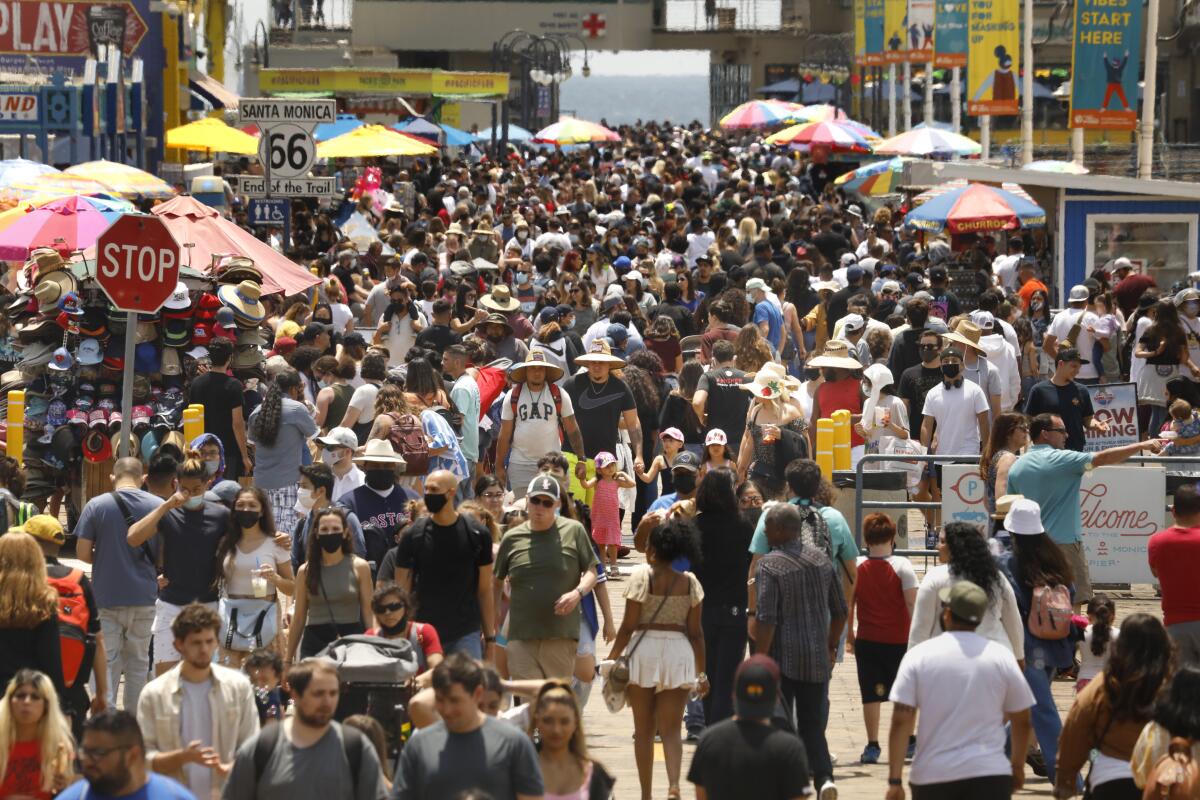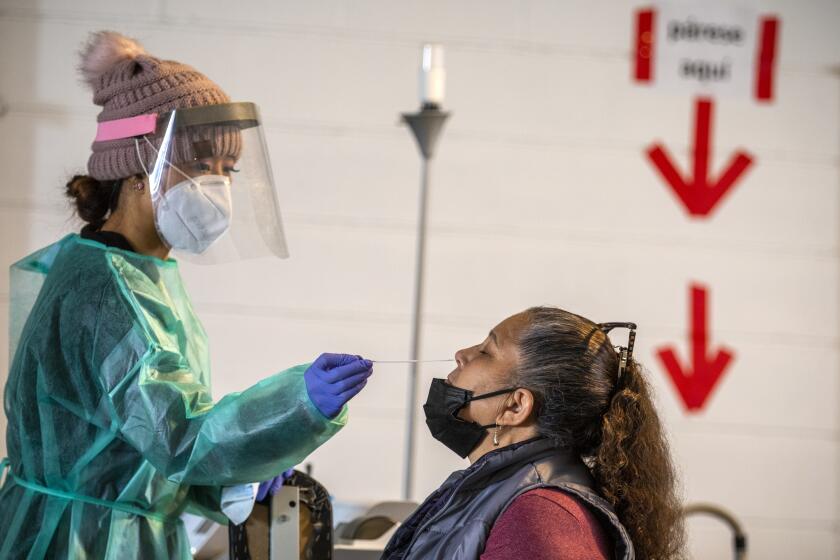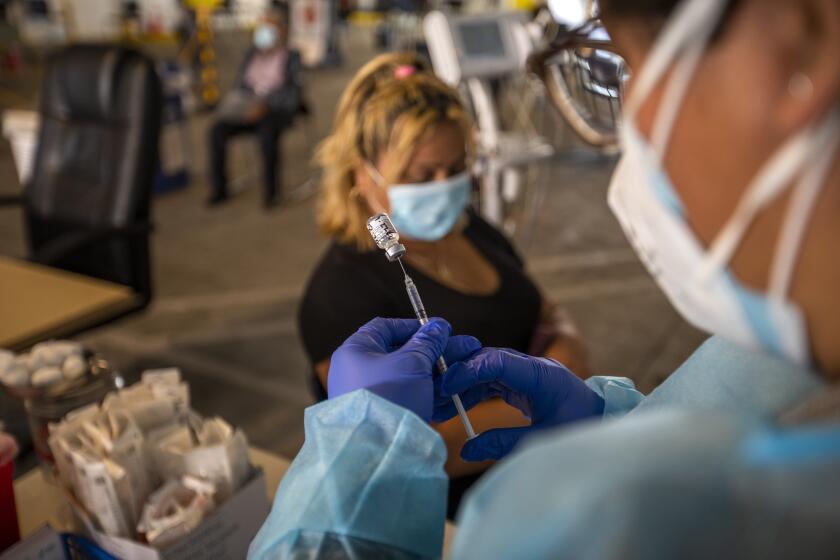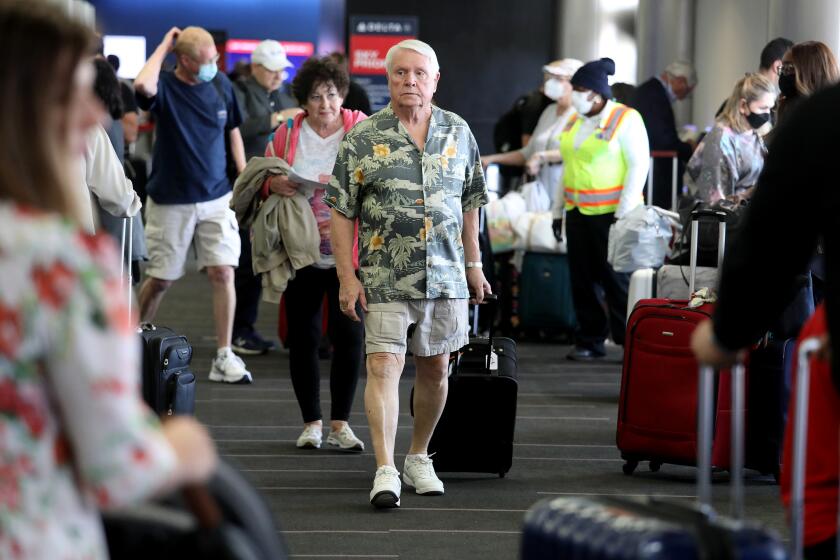California again faces rising anxiety about coronavirus spread as summer approaches

- Share via
SAN FRANCISCO — California is approaching another summer amid growing anxiety over COVID-19 as outbreaks increase and officials try to determine when this new wave will crest.
Although case rates are climbing, experts note they are doing so at a more modest pace than the first Omicron surge, which began spiking in December. California’s per capita COVID-19 hospitalization rate is also lower than some states on the East Coast.
But with Memorial Day, graduations, proms and other seasonal events on the horizon, officials are concerned about the upward trend worsening.
“We are seeing more activity, and so it is time to break out your mask and break out your tests and just be a bit more cautious than maybe you were a month ago,” said Dr. Sara Cody, public health director and health officer for Santa Clara County. “Even if you got Omicron during the Omicron surge, you can still get COVID again, unfortunately.”
Coronavirus conditions are likely to worsen, with case rates rising and hospitalizations increasing, a Bay Area health official said.
California is reporting about 8,000 daily coronavirus cases in the last week, up 18% over the previous week’s tally of 6,800 cases a day. The statewide test positivity rate has climbed to 4%; a week ago it was 3%.
Coronavirus-positive hospitalizations also have started to tick upward, but the number of patients needing intensive care has remained relatively stable, hovering near record lows for the pandemic.
Health officials across the state widely agree that it’s prudent to take precautions when coronavirus transmission is high — including wearing masks in indoor public spaces, being up-to-date on vaccinations and boosters, and gathering outdoors when possible or increasing ventilation when meeting indoors.
The San Francisco Bay Area has California’s highest coronavirus case rate — nearly double that of Southern California — and coronavirus levels in sewage for much of Silicon Valley have more than doubled over the last two weeks.
“They’ve been steadily climbing for about a month, and they’re above what we saw at the height of Delta,” last summer’s dominant variant, Cody said of viral levels in wastewater.
Coronavirus levels in wastewater also are increasing in Yolo County, home to UC Davis, said Dr. Alexander T. Yu, an epidemiologist and infectious diseases expert with the California Department of Public Health who briefed the California Medical Assn. on Tuesday. The upward trend, which began in March and was most prominent in the Bay Area, is now increasing in most regions, Yu said.
There is, however, some suggestion that coronavirus levels in wastewater are starting to plateau in Orange County and San Francisco, Yu said.
“At both sites, you can see that the rise in concentration appears to be tapering off and, hopefully, are starting to plateau,” he said.
Coronavirus cases continue to rise in California, prompting one health official to say the state is heading into the next wave of the pandemic.
The Bay Area now has a rate of 226 weekly coronavirus cases for every 100,000 residents, up 14% over the prior week. The state as a whole was reporting 144 cases a week for every 100,000 residents, and Southern California’s rate was 134. A rate of 100 or higher is considered a high rate of transmission, the worst tier, according to the U.S. Centers for Disease Control and Prevention.
“We are also seeing a pretty significant uptick in reports of outbreaks from schools, worksites and other congregate facilities,” Cody said. “Many of them are related to social gatherings.”
Los Angeles County’s coronavirus case rate is also climbing.
According to data posted Wednesday, L.A. County was averaging 2,628 coronavirus cases a day over the last week, up from 2,168 a day for the prior week, a 21% increase. L.A. County’s weekly case rate was 182 for every 100,000 residents.
The number of coronavirus-positive people in hospitals on any given day over the last month in L.A. County have been fluctuating between roughly 210 and 270.
“To date, the increases in case numbers have not translated to increases in severe illness, with hospitalizations and deaths remaining low and decreasing,” the L.A. County Department of Public Health said in a statement Monday. “The lower numbers of hospitalizations and deaths reflect, in large part, the protection provided by the vaccines against the variants.”
However, L.A. County Public Health Director Barbara Ferrer cautioned residents to continue taking precautions amid a high rate of transmission.
“This month, there will be many opportunities for gatherings, including graduations, proms, and the upcoming Memorial Day holidays,” Ferrer said in a statement. “For these occasions to not contribute to the increasing spread of Omicron variants, we encourage attendees to take sensible precautions that will protect you and those around you, including staying outside as much as possible and wearing a mask when indoors.”
Over 10 months, COVID-19 vaccines prevented more than 1.5 million infections and about 20,000 deaths in California, a new study estimates.
Santa Clara County is also beginning to see a rise among coronavirus-positive hospitalizations. On April 26, there were 80; two weeks later, there were 121.
And health experts are beginning to warn that Omicron survivors can get reinfected. Experts had initially thought that surviving the first Omicron variant, BA.1, likely provided protection against subvariant BA.2. But that may not be true for the latest ascendant Omicron subvariant, BA.2.12.1.
Cody urged people to take precautions. “When COVID [conditions] start getting wild, you have to add on other layers: You have to mask indoors, test when necessary, try to take things outside if you can,” she said.
California state epidemiologist Dr. Erica Pan reiterated that Omicron can still be dangerous. While much has been said about Omicron being less likely to cause severe illness, its extraordinarily contagiousness means a lot more people can be simultaneously infected, and more people died during the fall and winter Omicron surge than the earlier Delta wave.
The deaths of more than 14,100 Californians from COVID-19 have been reported since Jan. 1, when Omicron was dominant, while the COVID-19 deaths of nearly 12,800 Californians were reported in the last six months of 2021, around the time Delta was dominant, according to state data.
“As people talk about Omicron being milder … the deaths overall in the peak were definitely higher during Omicron than during Delta, for example, with such a high volume of cases,” Pan said in a talk with the California Medical Assn.
Two of three Californians live in counties in which coronavirus transmission is considered high, including Los Angeles, San Diego, Ventura and Santa Barbara counties, as well as every coastal county northward, along with the entire San Francisco Bay Area and Sacramento County.
Coronavirus cases have risen by nearly 30% in California over the last week. Hospitalizations are up, too.
But an analysis conducted by the state Department of Public Health of coronavirus cases and hospitalizations on a per capita basis also shows that California is doing better than Northeast counterparts like New York and Massachusetts.
“Thankfully, California has actually remained relatively low in comparison to the trends of these other states,” Pan said. “We’ve been watching this very, very closely, but it’s somewhat reassuring that our hospitalizations have not increased at the same pace as some of the other states.”
While the East Coast has sometimes been a precursor of what will come in California, there have been times when COVID trends in other states haven’t emerged here. For instance, in the spring of 2021, Dr. Rochelle Walensky warned of a feeling of “impending doom” about the pandemic when case rates were rising; but those ended up being limited to parts of the Midwest, and the rest of the nation continued its recovery until the summer Delta surge hit.
Also of note, the Omicron subvariants BA.4 and BA.5, which have been blamed for a new surge in South Africa, have not gripped California in the same way.
“We have seen a handful of these in California as well and are monitoring it closely. But so far it has not taken off in the same way as it has in South Africa,” Pan said. South Africa might be more hard-hit by BA.4 and BA.5 because the country didn’t see as much of a BA.2-fueled surge, she said.
California has also benefited from the widespread availability of anti-COVID drugs. Newly infected people can get prescriptions from health providers and “Test to Treat” sites at select pharmacies.
“More and more, we have ample supply now of antivirals, so Paxlovid, we have plenty of supply, and then molnupiravir as well,” Pan said, referring to the two drugs that can be taken orally. “There is no shortage anymore.”
Oral anti-COVID medications must be taken within five days of the first COVID-19 symptoms. Of the two, Paxlovid is considered more effective.
More to Read
Sign up for Essential California
The most important California stories and recommendations in your inbox every morning.
You may occasionally receive promotional content from the Los Angeles Times.















